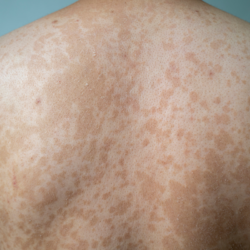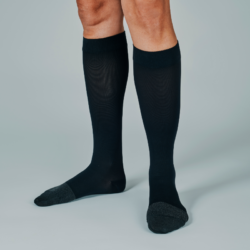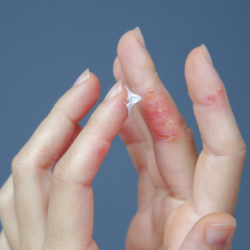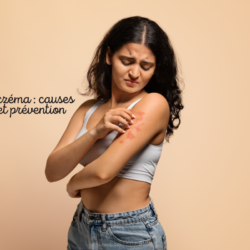When the little accidents of everyday life cause minor wounds, it’s perfectly possible to treat them at home. Scratches, scrapes and cuts always hurt! The usual reflex is to immediately apply a plaster. Which isn’t really a bad thing, given that a plaster is essential to heal and protect the wound.
Why put on a plaster?
It is recommended to apply a dressing to wounds once they have been disinfected. The aim is to maintain a healthy environment around the wound to encourage the healing process. The dressings will cover the wound and prevent impurities and pathogens (bacteria, viruses, fungi, etc.) from contaminating it. If this happens, you are exposing yourself to complications and even serious infection.
However, there are some crucial steps to follow before applying a dressing. First of all, you need to clean the wound with water and neutral soap, rinse thoroughly, dry (by dabbing gently with a cotton wool pad) and apply a bandage
then disinfect it with an antiseptic spray or liquid. The next step is to choose a suitable dressing, as not all dressings are suitable for all lesions. So which dressing is right for which wound? Here’s everything you need to know.
What are the different types of wound?
Superficial wounds
Superficial wounds are characterised by lesions that affect only the outer layers of the epidermis. Typically, these are scratches, minor cuts or abrasions, often resulting from domestic accidents or everyday activities. These wounds are generally shallow and bleed very little. The main aim of treatment is to prevent infection and promote rapid healing.
It is important to clean the wound carefully, using water and a mild soap to remove all traces of dirt. The application of a disinfectant is recommended to reduce the risk of infection. Next, an adhesive or hydrocolloid dressing can be applied, depending on the size and location of the wound. These dressings offer protection against bacteria and maintain a moist environment conducive to healing.
Deep wounds
Deep wounds are more complex and may involve subcutaneous tissue, muscle or even bone. These wounds usually occur as a result of more severe trauma, such as road accidents, falls or sharp injuries. The management of these wounds requires special attention, as they present a high risk of infection and complications.
A medical assessment is often necessary to determine the severity of the wound and the appropriate treatment. Deep wounds may require suturing or other surgical interventions. In terms of dressings, alginate or hydrofibre dressings are frequently used. They are able to absorb a large amount of fluid and are therefore ideal for exuding wounds. It is crucial to follow medical instructions for dressing changes and to watch out for any signs of infection or complications.
Infected wounds
Infected wounds represent a major challenge in the healing process. A wound is considered infected when it is colonised by bacteria, which can slow healing and cause symptoms such as redness, heat, swelling, pain and sometimes fever. The presence of pus or a foul-smelling discharge is also an indicator of infection.
The treatment of infected wounds often requires the use of antibiotics and special dressings with antimicrobial properties. These dressings may include active ingredients such as silver or iodine, which are known to be effective against a broad spectrum of bacteria. It is essential to clean the wound regularly and change the dressing in accordance with medical recommendations. In some cases, close medical monitoring is necessary to prevent the spread of infection and promote safe and effective healing.
The different types of dressing
There are many different types of dressing, depending on the type of wound. Some of the most commonly used are:
-
Dry dressings :
This takes the form of a thin, non-impregnated compress secured with adhesive. This is the form of dressing most commonly used on superficial wounds. As it does not maintain a moist environment, the wound must first be cleaned and disinfected using an antiseptic product.
-
Moist dressing :
This consists of applying a warm or cold wet compress to the wound. This may be a dressing soaked in antiseptic (alcohol) or antibiotic. Warm moist dressings are used in cases of inflammation, to reduce the pain and swelling of abscesses, panarias or boils. Cold moist dressings, on the other hand, act as decongestants and analgesics for bone injuries such as dislocations.
-
Greasy dressing with biogas or greasy tulle:
Dedicated to the treatment of burns and pressure sores and renewed every day, they promote healing and regeneration of the epidermis. Greasy dressings are made from compresses pre-soaked in oil or a mixture of products with an anti-inflammatory or antibiotic action, or based on ointment or balm to help reconstitute the skin.
-
Hydrocolloid dressings:
It speeds up the healing of blisters.
-
Spray dressing:
Ideal for areas of the body where adhesives won’t hold.
For each type of dressing, you will find different sizes depending on the size of the area to be covered. Their shape also varies according to the location of the injured skin to be protected and the anatomical constraints (finger, joint, torso, etc.).
Factors influencing the choice of dressing
When choosing a dressing, a number of factors need to be taken into account to ensure optimal, comfortable healing. These factors include the size and location of the wound, the sensitivity of the skin, and the underlying medical conditions of the injured person.
Size and location of the wound
The size and location of the wound are decisive in the choice of dressing. For small, superficial wounds, simple adhesive dressings may suffice. On the other hand, for larger wounds or wounds in areas of the body subject to frequent movement (such as joints), it may be necessary to use more flexible and resistant dressings.
The location of the wound also influences the type of dressing. For example, for a wound on thin, delicate skin, such as the face, it is preferable to choose a thin, discreet dressing, which minimises the risk of scarring. Conversely, for wounds on parts of the body that are less visible but perhaps more prone to friction, such as the knees or elbows, a thicker, more resistant dressing is recommended.
Skin sensitivity
Skin sensitivity is another crucial factor to consider. Some people have sensitive skin or are prone to skin allergies. For these individuals, hypoallergenic, latex-free dressings or dressings with gentle adhesives are essential to avoid skin reactions such as contact dermatitis.
It is also important to take into account the condition of the skin around the wound. Dry or eczematous skin will require a different dressing to normal skin, just as moist skin, as in the case of excessive sweating, will require a dressing that adheres well despite the moisture.
Underlying medical conditions
Underlying medical conditions can also influence the choice of dressing. For example, diabetic patients, who often have reduced blood circulation, require special wound care to prevent infection and promote rapid healing. For these patients, dressings that promote oxygenation and avoid excessive pressure are preferable.
In addition, certain illnesses, such as immune disorders, can slow down the healing process. In these cases, dressings with antimicrobial agents may be necessary to reduce the risk of infection.
Managing infected wounds
The management of infected wounds is an essential component of wound care. An infected wound, if not treated correctly, can lead to serious complications and delayed healing. It is therefore crucial to know how to recognise an infected wound, choose the appropriate dressings and follow additional advice to promote effective healing.
Recognising an infected wound
Knowing how to identify the signs of an infected wound is fundamental to rapid intervention. Common symptoms of infection include
- Redness around the wound, often accompanied by a feeling of warmth.
- Swelling or oedema around the affected area.
- Increased pain, sometimes throbbing or stabbing.
- Pus or foul-smelling discharge.
- In more serious cases, the sore may cause fever and chills.
It is essential to consult a healthcare professional if any of these symptoms are observed, especially if the wound shows no signs of healing or if the symptoms worsen.
Appropriate dressings
The choice of dressing is crucial in the management of an infected wound. The dressings used must not only protect the wound from external pathogens, but also absorb exudate while maintaining a moist environment conducive to healing. Recommended types of dressing include:
- Dressings impregnated with antimicrobial agents, such as those containing silver or iodine, which help fight bacteria.
- Absorbent dressings, capable of managing the high levels of exudate often produced by infected wounds.
- Hydrofibre or alginatedressings, which can be used in cases of heavy exudation, while providing the necessary antimicrobial properties.
It is essential to change these dressings regularly and to follow the instructions of a healthcare professional to avoid any worsening of the infection.
Further advice
As well as using appropriate dressings, here are some additional tips for managing infected wounds:
- Regular cleaning of the wound, following medical recommendations, to remove debris and exudate.
- Continuous monitoring of the wound to detect any changes in symptoms or appearance.
- Maintain good general hygiene to minimise the risk of spreading infection.
- Balanced nutrition and adequate hydration to support the healing process.
- Avoid touching or scratching the wound to prevent further infection.
URGO, the made in France reference for dressings!
As the market leader in dressings since 1880, Urgo HealthCare offers the general public simple, accessible and effective solutions to everyday problems. These include the dressings that every first-aid kit worthy of the name should contain:
-
Urgo Pansement protection effet tatoo x16 :
To treat your child’s little boo-boos from the age of 3. These fantastic tattoo plasters featuring fabulous characters such as the little fairy, the unicorn and many others will effectively protect our little ones’ wounds from germs, dust and bacteria. Not only does this tatoo bandage adhere perfectly to the skin, it’s also water-resistant. Yes, your child will be able to play and even bathe without any risk of infection to the wound. Soft and hypoallergenic, it’s ideal for children’s sensitive skin.
-
URGO Superficial Burns 4 Large Dressings :
For treating superficial 2nd degree burns or superficial wounds such as cuts and abrasions. Consisting of a weave impregnated with hydrocolloid particles and vaseline, the Urgo superficial burns dressing relieves pain and promotes healing. The box contains 4 large dressings (10 x 7 cm) to cover the surface of the wound. This dressing is flexible and conformable and does not stick to the wound. No more pain on removal!
-
URGO Spray Dressing 40ml bottle:
Invisible spray dressing, recommended for joints and articulations (elbows, knees). It is water and abrasion resistant. This discreet dressing preserves the wound and promotes healing.





